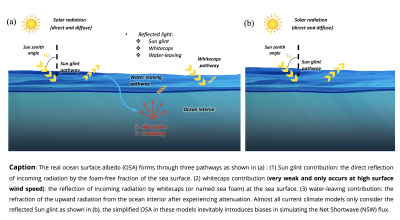Sensitivity of Arctic Surface Temperature to Including a Comprehensive Ocean Interior Reflectance to the Ocean Surface Albedo
The sensitivity of arctic surface temperature to including a comprehensive ocean interior reflectance to the ocean surface albedo (OSA) was assessed using the fully coupled Community Earth System Model version 2 (CESM2).
Almost all current climate models simplify the ocean surface albedo (OSA) by assuming the reflected solar energy without the ocean interior contribution. This study examines the responses of Arctic surface temperature by evaluating two OSA methods – one with and one without considering ocean interior reflectance in the OSA. The findings reveal that ocean interior reflectance increases absorbed solar radiation and warms the ocean, enhancing seasonal heat storage and release across the Arctic Ocean and increasing sea ice reduction and positive climate feedback that elevates Arctic surface temperature. Significant effects of ocean interior reflectance on the Arctic Ocean, including sea surface warming and sea ice reduction, justify the importance of ocean interior reflectance in climate models to better understand ongoing Arctic climate changes.
Many climate models neglect the contribution of ocean interior reflectance to the ocean surface albedo (OSA) and hence simulate less accurate net heat flux through the air-sea interface. This study performed sensitivity simulations with and without ocean interior reflectance in the OSA calculation, respectively. When ocean interior reflectance is included, the Arctic surface shows warming in both summer and winter, and the warming is stronger in winter due to complex feedback mechanisms in the fully coupled model. Seasonal variations in air-surface temperature differences induce changes in turbulent heat flux patterns, concurrently modifying dynamic advection and moisture processes that affect boundary layer humidity and low clouds, especially in winter. Based on partitioning physical processes in the thermodynamic energy equation, surface air warming is induced primarily through positive heating anomalies of vertical advection, latent heat release, and longwave radiative forcing. Examining the surface energy budget reveals that skin temperature warming is driven predominantly by increased downward longwave radiation, positive surface albedo feedback in summer, and increased conductive heat transport from the ocean particularly in winter.

